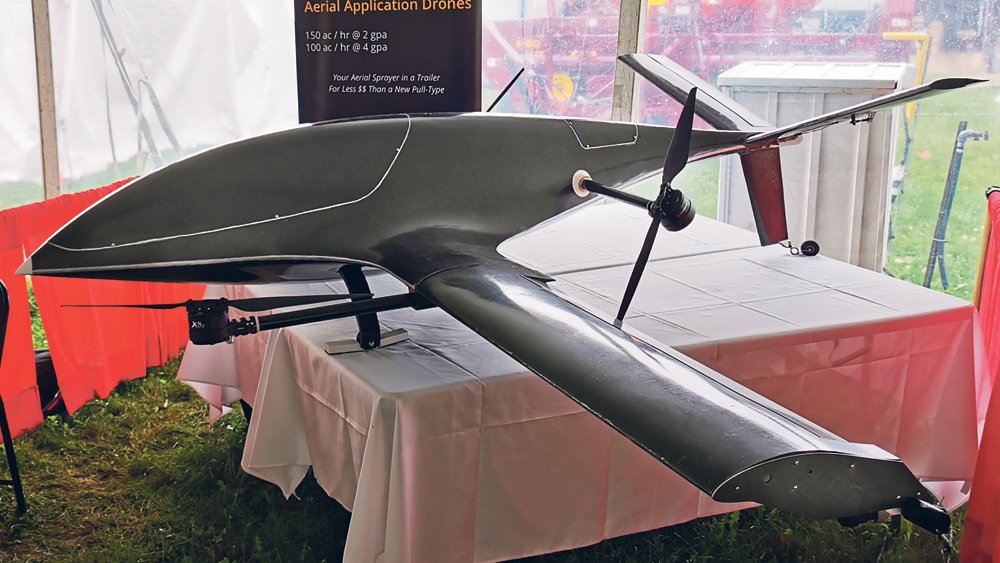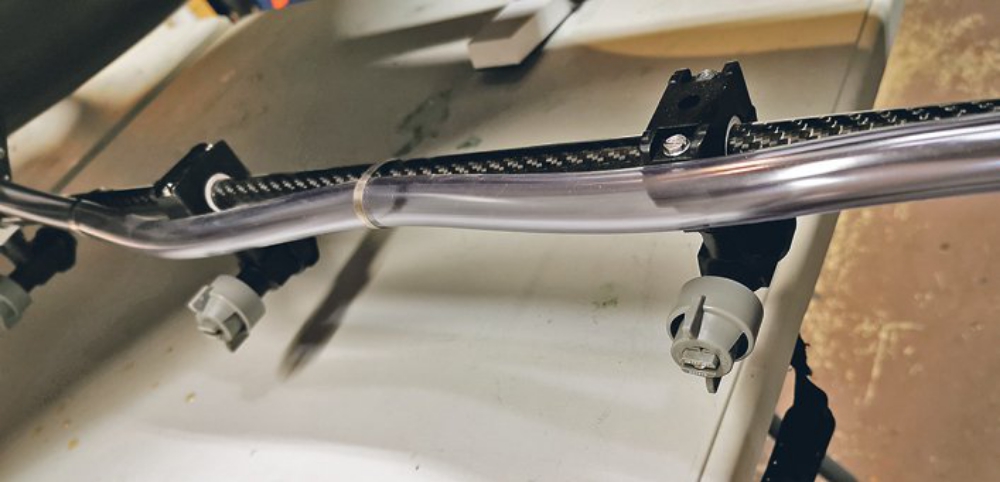Drones designed to spray broad- acre agricultural crops usually use fine droplets with a low water-to-chemical ratio to try and make up for their limited fluid carrying capacity. This greatly limits their use, because extremely low water volumes are off-label and fine droplets are prone to drift, where they might take out a neighbour’s crop.
So Kitchener-based start-up, Forward Robotics, designed their drones to spray similar rates and droplet sizes to agricultural spray planes.
The design of the U7AG drone started when the company’s chief executive officer, Meng Wei, and co-founder Tamara Finlay figured out how to vertically take off and land a fixed-wing drone for a 2018 competition.
“We realized this technology is actually very good for doing very rapid landing, refill and take off for an aerial sprayer,” Wei said.
Wei graduated from the University of Toronto aerospace engineering program and used to be the lead flight control engineer of Google co-founder Larry Page’s flying car project, while Finlay has a PhD from the University of Toronto in aerospace studies.
During vertical takeoff and landing all four rotors are pointing up, while in forward flight, the rear rotors are tilted forward while the front ones shut off.
“The key technology is the flight control algorithm that rapidly and finely adjust the precise angle of the thrust vectors, which allow our aircraft to maintain stability during very aggressive maneuvers, such as during rapid refill,” Wei said.
The U7AG has a base wingspan of 3.5 metres, but the spray booms extend past the wings to a total width of seven metres.
The aircraft has a maximum take-off weight of up to 75 kilograms, an internal chemical holding capacity of around about 45 litres, travels at 100 km-h while spraying, and can fly for half an hour on one charge.
“But the most important thing is we actually are not aiming for flight-time because we have a fully automated refilling system that the aircraft can automatically land when its tank is depleted to refill itself back up and then resume spraying again,” Wei said.
During the refilling process, the drone’s battery also gets topped off, which Wei said greatly increases the aircraft’s up time.
Charging the battery from empty takes around one hour, but during spraying the battery is constantly topped up during refills.
He said and the company is designing the system so the drone can operate continuously with a 1.5-minute spray time and a one-minute refill and recharge time.
“As far as the users are concerned, you just tell the system to go, and it will spray the entire field. It will refill itself, recharge itself when the tank is empty or the battery is empty. With no human intervention,” Wei said.
“You don’t have to do anything until the entire operation is complete.”
The drone is still undergoing testing, but Wei estimates at four gallons per acre the drone will be able to cover 100 acres an hour.
He said at 10 gallons per acre the drone can cover 50 acres per hour, and at two gallons per acre it could probably cover up to 150 acres per hour.
“We designed it to be similar to existing manned aviation and similar to what label recommends in terms of water volumes,” Wei said.
“We designed for is about four to five gallons per acre, which I believe some aerial fungicides have that recommendation for aerial application.”
He said the nozzle and droplet size are medium to coarse, which combined with the fixed-wing aspect of the drone, helps prevent spray drift.
“The idea is to produce a much more predictable and controlled drift situation compared to the ultra fine droplets behind rotors for the other drone systems,” Wei said.
Application expert Tom Wolf, of Agrimetrix and sprayers101.com, said he was impressed with the drone when he came across it at Canada’s Outdoor Farm Show in Woodstock, Ont.
“I immediately saw it had good nozzles on it,” Wolf said.
“Drones often come with hollow cones, which are super, super fine. The biggest problem for us in ever making drones successful is managing the drift potential.”
He said drones for spraying should be taken seriously because the technology is widely used in some Asian countries, but that Canadian regulations need to be developed to ensure the technology is used in a way that promotes proper stewardship.
The U7AG drone use GPS and will likely be fitted with an RTK system when sold commercially to provide centimetre precision of the aircraft when in operation.
It also has a pressure altimeter and laser altimeter that determines canopy height.
“Right now, the design includes a downward looking laser altimeter and a forward inclined, forward looking laser altimeter to determine the upcoming terrain as well as the current altitude,” Wei said.
There are also standard sensors such as air speed and inertial measurement unit (IMU) sensors.
The first time the system is used, operators will have to define the boundaries of the field and the location of any obstacles.
This information is stored in the field station, which also calculates the optimal trajectory of the flight path.
“The operation basically involves connecting with the aircraft after power up, and loading the preloaded flight path, there will be a preflight check, it will ask a couple questions, you will visually check it as well, and then the last action will be pressing a button.”
He said he envisions two operational models for the platform. One is for the ground station to be located at the farm close to a large chemical tank for refilling, while the control system that communicates with the ground station can be portable.
“It can be on the farm somewhere, say next to a field. You will, through the radio you will remotely activate the system and use the ground station to tell it to go.”
The other operational model would be a trailer-based set up that would work for custom applicators and large farms.
“Take the trailer out, put it next to a field, connect it with your laptop, enter your farm’s co-ordinates, tell it to go and it will go.”
“It’s similar to what you would do for a crop scouting drone.
He said users will be able to use multiple drones at the same time, because Transport Canada rules allow up to five aircraft to fly at the same time with one operator.
Transport Canada regulations require operators have line of sight to the drone at all times, and a Special Flight Operations Certificate is required to fly a drone over 25 kilograms.
The Pest Management Regulatory Agency (PMRA) website states it has not approved any product for aerial drone applications in Canada.
The company is targeting $50,000 for the whole system, and to launch commercial sales in 2020.
To examine the efficacy of the drone in spraying, Wei said the company is hoping to work with crop protection companies next year on research farms.
There will also be trials using dyed water to examine drift on approximately a dozen farms next summer.
Source: The Western Producer


